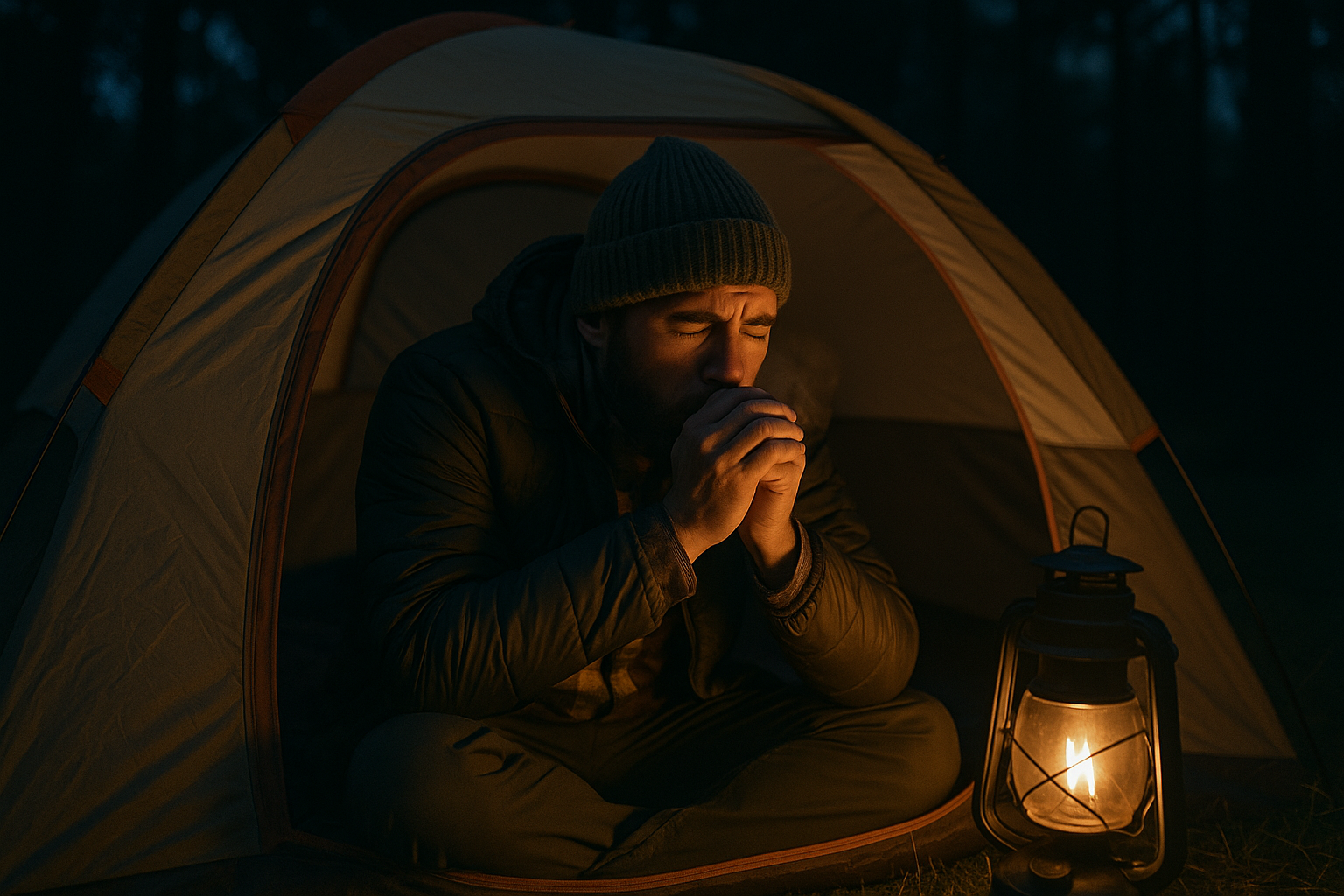You’re tucked into your sleeping bag.
The night is silent.
And then—it starts.
A dry, tickling cough that won’t stop.
Every inhale feels like icy sandpaper.
Your throat burns. Your lungs feel raw. And sleep? Impossible.
If you’ve ever camped in sub-freezing temps, you know this feeling.
This isn’t just annoying—it’s dangerous.
Let’s break down why cold air triggers nighttime coughing and how to stop it with proven, packable breathing techniques that protect your lungs—and your sanity.
🧠 Why Cold Air Triggers Coughing at Night
💡 The Science:
When cold, dry air enters your lungs:
- It dries out your airway lining
- It triggers nerve endings in the trachea and bronchi
- It increases inflammation, especially in people with mild asthma, allergies, or prior respiratory issues
According to Dr. Yury S. Polozov, a respiratory therapist and backcountry medicine educator:
“Cold air at rest is denser and drier. When you inhale it without warming, it irritates the mucosa and triggers an immune response—even in healthy lungs. This can lead to coughing, throat pain, and even bronchospasm.”
🔥 The Solution: Warm the Air Before It Hits Your Lungs
You don’t need a furnace.
You just need strategic breath management, gear placement, and airflow redirection that adds a few degrees of warmth—enough to calm your respiratory system and let you sleep.
Here’s how to do it.
✅ 1. Use a Breath-Filtering Buff (and Don’t Let It Get Soaked)
Your first defense is external—create a warming layer for air intake.
How:
- Wear a buff or neck gaiter over nose and mouth
- Sleep with it slightly loose, not suctioned to your skin
- Use double-layered merino or synthetic fleece that holds warmth but doesn’t trap moisture
Gear Suggestions:
- Smartwool Merino 250 Buff
- Zpacks Ventum Hooded Balaclava
- OR Option Balaclava (with breathing mesh)
🧠 Rotate between 2 buffs on multi-day trips—one for sleeping, one for hiking.
✅ 2. Practice the “Heat Cycle” Breathing Method
Cold coughing gets worse when you inhale quickly and deeply, pulling icy air straight to the lungs.
Use This Instead (Dr. Polozov’s Sleep-Safe Pattern):
- Inhale slowly through the nose for 3–4 seconds
- Pause for 1–2 seconds
- Exhale gently through pursed lips for 6–8 seconds
- Wait 2 seconds, then repeat
Why it works:
- Nasal passages pre-warm air through capillaries
- Pausing slows respiratory flow
- Pursed-lip exhalation maintains positive airway pressure, helping retain internal warmth
🧠 This is a modified version of “Buteyko breathing,” often used in asthma and COPD care.
✅ 3. Face Your Body, Not the Tent Wall
Where you sleep affects what air you breathe.
Rule of thumb:
- Never sleep facing into open air inside a tarp or tent
- Instead, sleep curled with your nose near your chest or forearm
- This creates a localized warm air pocket that slightly pre-heats your next inhale
Bonus: It also buffers crosswinds or tent drafts from hitting your face.
✅ 4. Sleep With a Warm Buffer Near Your Face (But Not Inside Your Bag)
Your sleeping bag is not the place to trap breath—but you can trap warmth near your breathing zone.
Try This:
- Fill a dry bag or sock with warm clothing
- Place it just above your chest, angled near your nose
- Your breath will bounce against it and create a mini warmth loop
🧠 This technique mimics how dogs and animals curl with paws over nose in the cold.
✅ 5. Avoid Hyperventilation by Controlling Heat Anxiety
Many campers unconsciously start over-breathing when they feel cold.
This:
- Increases evaporative heat loss through lungs
- Draws in more cold air
- Triggers panic and shallow coughs
Fix:
- Use a 4-7-8 breathing pattern to calm nerves:
- Inhale for 4
- Hold for 7
- Exhale for 8
- Focus on breathing with your diaphragm, not your chest
This slows your system and lets your upper airway stabilize thermally.
✅ 6. Build a Face Tent (Without Creating Condensation)
When all else fails and the air is bitingly cold, try this:
DIY Face Tent:
- Drape a bandana, t-shirt, or mesh cloth from your hat brim
- Let it hang loosely over your nose and mouth
- Secure sides with a safety pin or buff
What it does:
- Traps warm exhaled air around face
- Still allows airflow
- Reduces direct air exchange without wetting your bag
🧠 Unlike breathing into your bag, this creates a condensation-safe microclimate.
✅ 7. Hydrate Differently Before Bed
Cold air dehydrates you faster than warm.
When your throat is dry, your cough reflex becomes hypersensitive.
Expert Tip:
- Drink warm or room-temp water with electrolytes or honey an hour before bed
- Avoid sugary tea or alcohol—they dry your throat
- If available, use a few drops of saline nose spray to keep nasal passages moist
Pro Pick:
- LMNT Electrolytes (sugar-free, camp-safe)
- DripDrop ORS powder
- Xlear Xylitol + Saline Nasal Spray
🧠 Hydrated sinuses = less irritation, less coughing.
🔥 Advanced (Optional) Gear for Lung-Sensitive Campers
If you’re prone to bronchitis, asthma, or winter coughing, consider packing:
💨 1. Cold Weather Breathing Masks
- Used by military and mountaineering athletes
- Designed to warm air before it hits lungs
- Examples: ColdAvenger Pro Respirator, AirTrim Heat Exchange Mask
Pros:
- Legit lung protection
- Can reduce cold-triggered bronchospasms
Cons:
- Adds weight (~3–6 oz)
- Less stealthy, looks tactical
🌡️ 2. Self-Heating Neck Gaiters
- Gaiters with built-in heat-retaining panels or exothermic material
- Brands like Ignik and Thermarator™ by Columbia
Bonus:
Great for solo motorcycle or alpine campers needing lung-safe sleep at elevation.
🧭 Recap: Nighttime Cold Coughing Fixes (No Fire Needed)
| Problem | Fix |
|---|---|
| Dry, cold air in lungs | Use buff or mesh face cover |
| Rapid inhale triggers cough | Practice nose-to-lip breathing |
| Wind exposure to face | Sleep facing torso or use face tent |
| Bag condensation from breath | Never breathe into bag; use external warmth |
| Dehydrated airways | Drink electrolytes + saline before sleep |
| Chronic winter coughs | Upgrade to warming mask (ColdAvenger style) |
🌄 Final Thoughts: Don’t Let Cold Air Steal Your Breath—or Your Sleep
Nighttime cough from cold isn’t just uncomfortable.
It ruins recovery, saps morale, and damages your lungs long after the trip ends.
But now you have real survival breathing tools:
- Body-position hacks
- Breath-control drills
- Smart gear choices
All designed to help you breathe warmer, sleep deeper, and wake up stronger—even in zero-degree backcountry cold.

